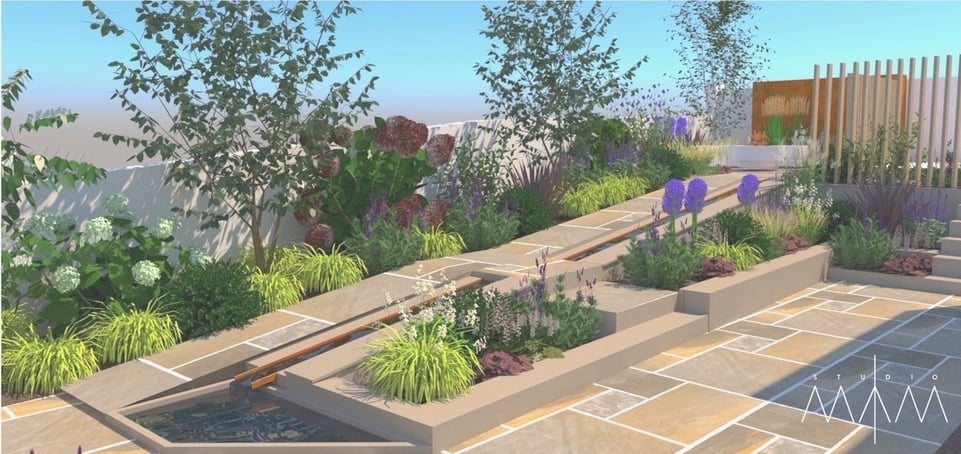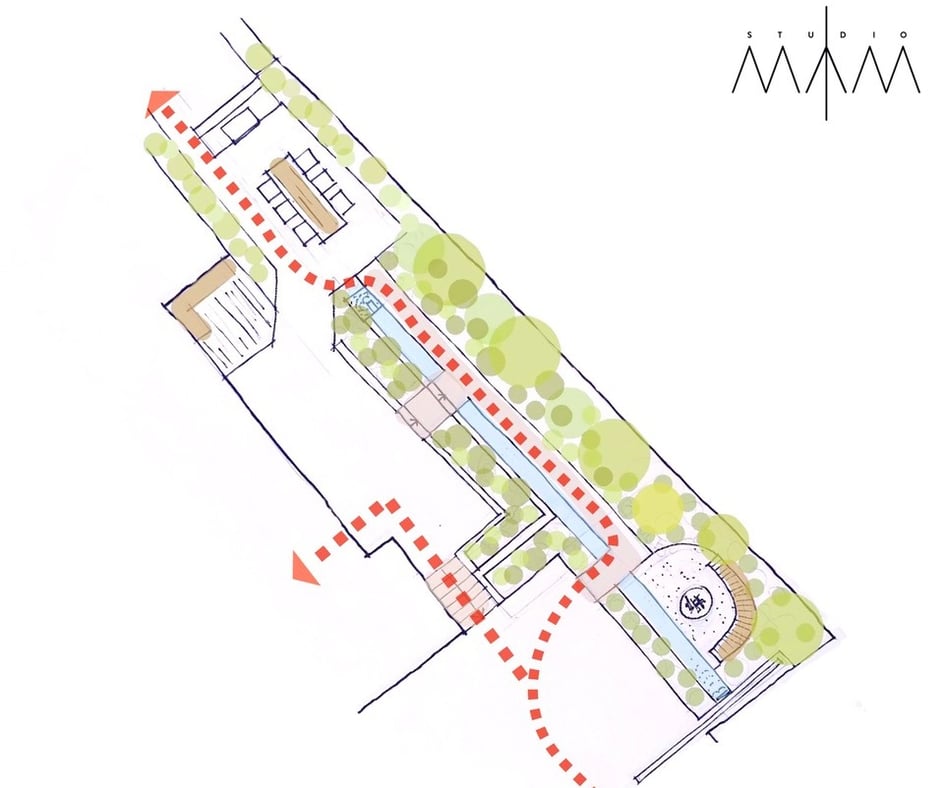When you’re setting out on your self-build journey, you’ll be itching to get started on designing your dream home. However, there’s no point in building that dream home if it looks out onto a muddy, uninspired field.
Your outdoor space is equally as important. You want to look out of your window onto a stunning and unique landscape that’s fit for all seasons and tailored to you. Your garden works should be planned for from the very beginning, and hiring a Landscape Designer could be the key to achieving that goal.
A Landscape Designer should be proficient in horticulture, interior spaces, artistic design and should set out to blend your spaces into one. We sat down with MarieAnne Messenger of Studio MA to discuss the role of a landscape designer in a self-build, and why you should consider getting one on board.
WHEN SHOULD A CLIENT START LOOKING FOR A LANDSCAPE DESIGNER?
When it comes to self-build and major renovation projects, landscaping shouldn’t be an afterthought or an element which is rushed at the end of the project, so the earlier a client engages with a designer the better! Appointing a professional early in the project not only helps them to consider and realise the potential of their outdoor space, but also ensures that factors such as functionality, aesthetics, programme and budget are highlighted and addressed early on in their project.
Not having a plan to work towards inevitably adds unnecessary stress to the design process which leads to hasty decision-making, mistakes, aesthetic compromises and most often regret further down the line. That is where a Landscape Designer can come in to take the reins.
Landscape Designers work alongside Architects to create designs which go beyond the aesthetics, creating functional outdoor spaces for relaxation and entertaining. Their emphasis on integrating nature to soften the built environment provides that vital connection between the interior and the exterior.
In terms of the time of year, it works well to develop the design during Autumn and Winter, in preparation for Spring installation so that the space is ready for Summer use.
For a smaller project, the designer can be appointed at any time. However, reputable Landscape Designers are in high demand, so timings all coincide with their availability and existing project commitments - so it’s good to get one booked in at the early stages of your build.
WHAT ARE THE BENEFITS OF HIRING A LANDSCAPE DESIGNER?
Undertaking new projects can be overwhelming, time-consuming and costly. Hiring a professional Landscape Designer to guide the client, step by step through the process can help immensely when it comes to drafting the design proposals.
A Landscape Designer can help the client answer overwhelming questions such as, what do we do? Where do we start? Am I making the right decisions? This gives you confidence as the client to commit and undertake the work, and they can guide you through that with their design expertise.
Their in-depth knowledge and understanding of the space allow them to create proposals that are unique to your property and lifestyle. With a deep understanding of the environment, they can help you select beautiful plants that will thrive in your garden.
They work closely with their clients to help them maximise their outdoor living space within their allocated budget.
The main benefit of hiring a Landscape Designer is the added reassurance and clarity of the design of your landscape. Having a master plan in place for the project will help guide you as a client along the way, and allow works to be phased if required, letting you know that everything has its place and will all come together.
You can also save time by allowing your Landscape Designer to manage the project and guide you through the process from beginning to end.

Creating spaces suitable for seasonal change is one of the key factors when designing outdoor spaces, no matter how big or small those spaces are. Consideration is always given to seasonal interest.
Landscape Designers introduce design elements which carry your space throughout the year and embrace all seasons. Spring and Summer bring an abundance of colour with flowering herbaceous perennials and shrubs, so your space should embrace these plants in those precious months. Autumn brings a lot of texture from seed heads and deciduous foliage changes colour. When Winter comes, evergreen trees and shrubs provide the structure and come to the forefront of your space.
Outdoor lighting can truly transform the space. The key is not to floodlight the entire garden but instead highlight architectural features, plants or trees to showcase for a more dramatic effect. Lighting can be both functional and atmospheric when used to illuminate pathways and seating areas, allowing the garden to transcend from day to night and maximising the duration of time spent outdoors. Outdoor heating is another important aspect that keeps your garden functional when it starts to get colder. Patio heaters and fire pits can provide warmth and comfort and take the chill off seating areas.
This doesn’t just apply to the cold. Pergolas or trees which cast dappled shade are a great way to provide protection from the intense Summer sun.
AN OVERVIEW OF THE LANDSCAPE DESIGN PROCESS
The design process is phased in a collaborative approach with the client from start to finish. Every project is different, but the design process remains the same, and this applies to every project.
A good Landscape Designer should get to know their clients, tapping into their lifestyle and interests to create a space that aligns with their initial goals. This information helps to form a brief, which can be translated into a design.
At the beginning of every project, we set out our scope of works and services to ensure that our clients know what to expect throughout the design process. Their fees are also broken down into stages, which provides transparency to their clients.
The next stage would be to do the site appraisal and the survey, which provides the designer with all the information that they need to develop the design.
Like Architects, Landscape Designers use rendered visuals throughout the design process, which help bring the design to life. Clients find these aids useful when signing off finishes or planting styles, giving them a greater understanding of the overall look and detailing of the proposal and, in turn, the confidence to commit to the design and commission the work.

They always ensure that their designs comply with current building regulations and the planning guidance for the area that they work in. For example, Edinburgh & East Lothian-based properties are often within conservation areas, which have their own guidelines.
Design proposals within these areas require statutory approval from the relevant planning department before any work begins. Therefore, they ensure sufficient time is built into the design programme for the application process, which can take up to 3 months in some cases. This is to avoid halting any further work as we wait for approvals. That’s why it’s so important to do your research as a self-builder on the guidelines that apply to your area.
THE COSTS OF HIRING A LANDSCAPE DESIGNER
When it comes to hiring a Landscape Designer, your fees will most likely be relative to the area of your garden. Most works are based on a fixed fee scale, whilst other Landscape Designers may charge you a percentage of the project cost rather than an hourly rate.
Many design choices are reflected in the project costs. Bespoke elements elevate the space by providing that unique, fit-for-purpose piece but require additional design time to detail and specify, leading to increased build costs.
The specifications of finishes and the maturity of your planting proposed all affect the cost of your project. For example, the use of natural stone will bring a layer of authenticity to your landscape but will bring higher costs in comparison to porcelain pavers. The introduction of electrical, water and drainage works will add to the cost and timeline of your project too.
Most Landscape Designers have experience in working with any budget, but your design intentions and budget should be made clear from the outset.
DO YOU HAVE ANY ADVICE FOR SELF BUILDERS?
My advice to self-builders would be to consider the transition between your home and your outdoor landscape. Think about how you want to use the space available to you. Get an idea of what areas get the most sun when you position any terraces or seating areas.
It’s also important to set aside an allowance for planting as well as hard landscaping when allocating your budget because landscaping your grounds not only elevates your property, making it feel ‘finished’ but helps to soften the space and integrate it within the setting; creating a visual connection between the interior and the exterior.
We would like to thank MarieAnne Messenger for her expert contribution to ACA’s blog. If you would like to learn more about how Studio MA can create a unique outdoor space for your self-build, head to their website and contact their team to discuss your project.



